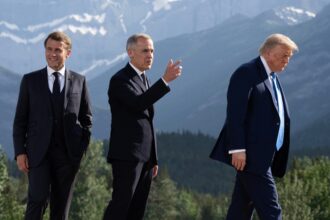In the pre-dawn darkness of Kyiv, air raid sirens pierced the silence as Russia unleashed one of its most aggressive aerial bombardments on the Ukrainian capital in months. The assault, which occurred early Thursday morning, appears to be direct retaliation for Ukraine’s daring drone strike against Russia’s strategic bomber fleet earlier this week.
Local authorities report that Ukraine’s air defense systems were engaged for nearly three hours as they worked to intercept incoming missiles and drones. Serhii Popko, head of Kyiv’s military administration, confirmed that all Russian projectiles targeting the city were successfully destroyed before they could reach their intended targets.
“This marks the ninth aerial attack on Kyiv since the beginning of November,” Popko stated via Telegram. “The enemy continues to test our air defense capabilities with combined attacks using various weapons.”
The assault on Kyiv comes just days after Ukrainian forces executed what military analysts are calling an “audacious and technically sophisticated” operation against Russia’s long-range bomber fleet. Satellite imagery analyzed by CO24 World News shows significant damage to at least two Tu-95 strategic bombers at the Engels air base, located over 600 kilometers inside Russian territory.
These Tu-95 bombers have been instrumental in Russia’s campaign of launching cruise missiles against Ukrainian civilian infrastructure, particularly targeting energy facilities as winter approaches. The Ukrainian strike represents a significant operational achievement, demonstrating their growing capability to conduct long-range precision attacks deep within Russian territory.
“This is a classic example of asymmetric warfare,” explains Dr. Marta Kowalski, military strategy expert at the Royal Military College of Canada, in an interview with CO24 News. “Ukraine is using innovative drone technology to strike high-value targets far beyond conventional battlefield boundaries.”
The pattern of Russian retaliation following successful Ukrainian operations has become increasingly predictable. According to CO24 Politics analysis, Moscow typically responds to battlefield setbacks with intensified attacks against civilian infrastructure, particularly in major urban centers like Kyiv.
Ukrainian President Volodymyr Zelenskyy addressed the nation following the attack, emphasizing the resilience of Ukrainian air defenses while reiterating his appeal to Western allies for additional advanced defense systems.
“Every intercepted missile, every downed drone represents lives saved,” Zelenskyy stated. “But our defense capabilities remain stretched as Russia continues to acquire missiles and drones from foreign suppliers.”
International reaction to the escalating aerial warfare has been swift. NATO Secretary-General Jens Stoltenberg condemned the Russian strikes on civilian infrastructure while reaffirming the alliance’s commitment to supporting Ukraine’s defensive capabilities.
Meanwhile, economic impacts continue to reverberate throughout the region. Energy commodity markets showed immediate volatility following news of both attacks, with European natural gas futures climbing 3.8% amid concerns about potential disruptions to Ukrainian transit infrastructure, according to CO24 Business market analysis.
As winter descends upon Eastern Europe, military observers note that both sides appear to be adjusting their strategies. Russia continues its systematic targeting of energy infrastructure ahead of freezing temperatures, while Ukraine demonstrates growing capacity to strike strategic military assets previously considered secure.
The question now facing military planners and diplomatic channels alike: Will this exchange of long-range strikes mark a new, more dangerous phase of the conflict, or could it potentially accelerate efforts toward meaningful negotiation as both sides demonstrate their capabilities to inflict significant damage?

























